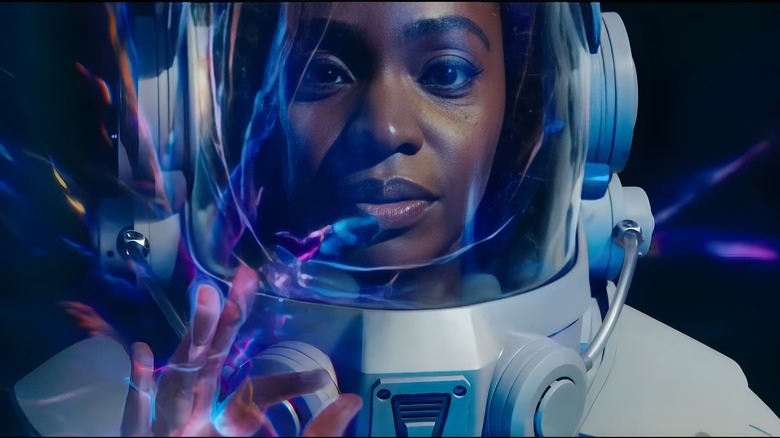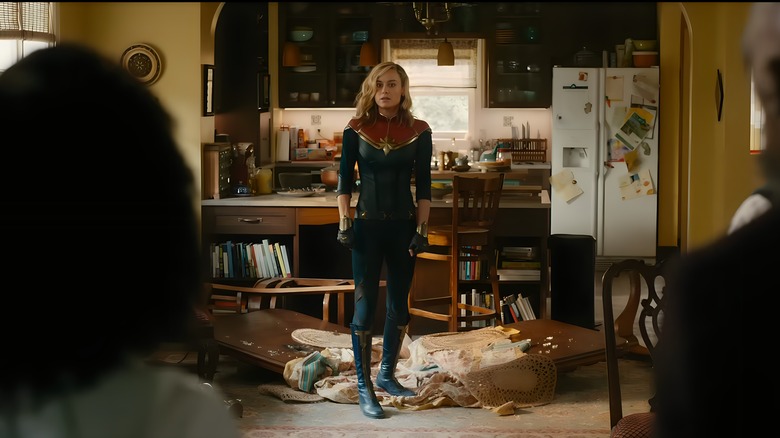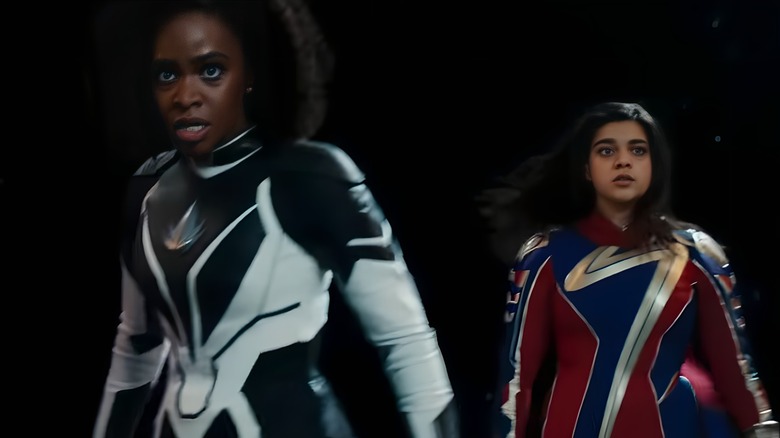The Marvels: How A 1960s Comic Inspired The MCU Film's Body-Swapping Premise
The Marvel Cinematic Universe is going in a bold new direction with "The Marvels."
The upcoming MCU film marks the first time Captain Marvel (Brie Larson), Photon (Teyonah Parris), and Ms. Marvel (Iman Vellani) will share the screen as a trio. One of the most highly-anticipated films in the franchise, "The Marvels" is directed by Nia DaCosta, who made waves with 2021's "Candyman." What makes "The Marvels" so unique in a pantheon of Marvel films is that it's a sequel to multiple films and projects. The epic takes place after "Avengers: Endgame," "WandaVision," "Ms. Marvel," and operates as a direct sequel to "Captain Marvel."
Beyond that, the film is set to highlight the daring physical and personal connections that the trio have with one another. While their skills and temperaments are different, they're bound together by one thing in "The Marvels": the ability to swap places. The post-credits sequence in "Ms. Marvel" sees Kamala Khan whisked away from her bedroom, only for her hero Carol Danvers to appear. In "The Marvels," the three characters are inexplicably linked, forcing them to swap places every time they try to utilize their powers. It's an inventive premise, one that forces the trio to work together — no matter how much they annoy one another.
While speaking with Entertainment Weekly, executive producer Mary Livanos opened up about how the body-swap premise was directly influenced by "Captain Marvel" comics from the '60s. Livanos notes how the OG Captain Marvel, known as Mar-Vell, was able to body-swap with Rick James using Kree bracelets. While the executive producer doesn't explicitly mention which comics the film was influenced by, it's hard not to imagine DaCosta and the film's writers taking cues from "Captain Marvel #16" and "#17."
The body-swapping premise has roots to the '60s
"Captain Marvel #16," which debuted in 1969, features Mar-Vell stuck in the Negative Zone thanks to his Nega-Bands. It wasn't until "Captain Marvel #17" that readers discover that, through the Nega-Bands, Mar-Vell can swap places with Rick Jones, thus freeing himself from the Negative Zone. Future "Captain Marvel" comics also make use of the Nega-Bands, making them a key part of the character's mythos.
In the Marvel Cinematic Universe, however, the Nega-Bands aren't technically associated with Captain Marvel. Instead, they're a major part of Kamala Khan's origins in the franchise. A family heirloom, Khan wields the bangles, only to receive superpowers from them. During the post-credits scene for "Ms. Marvel," Khan's bangles light up before she's whisked away and replaced by Captain Marvel. It remains to be seen if "The Marvels" will rely on the Nega-Bands which were prominent in those early "Captain Marvel" comics.
Executive Producer Mary Livanos remained coy about how exactly Photon, Captain Marvel, and Ms. Marvel are connected and able to swap places, but noted that all three characters utilize powers that are light-based. In the comics, the ability to swap places is treated as a strategic decision. In "The Marvels," it's explicitly clear that the ability is a hindrance, especially for Captain Marvel, who is used to working alone. "So, I think this is an incredible metaphor for learning how to be in a team," Larson said to EW about her character being forced to go from one place to another. "It's a very clear example that no one person can do it all," Larson continued, saying that a diverse team is needed to succeed.
How will The Marvels deal with the body-swapping?
From a narrative perspective, having the Marvels body-swap is brilliant, as it forces the trio to confront one another — especially when it comes to difficult conversations. While speaking with EW, Monica Rambeau star Teyonah Parris opened up about how she hasn't spoken to Captain Marvel in years. "Carol is such a huge part of Monica's life in 'Captain Marvel,'" Parris told the outlet. "When we see her in 'WandaVision,' you get a sense that she has not talked to Carol in a very long time. So, we have to address the elephant in the room."
And while Captain Marvel is more than likely dreading her chat with Photon — someone who she desperately needs to make amends with, it's her conversation with Kamala Khan about being a fangirl that's more than likely giving her a real headache. While it remains to be seen how the three are connected, it will be interesting to see if the body-swapping is something that is resolved once the curtains are called on "The Marvels," or if it will continue to be a power that appears in the future Marvel Cinematic Universe films.
"The Marvels" hits cinemas on November 10.


